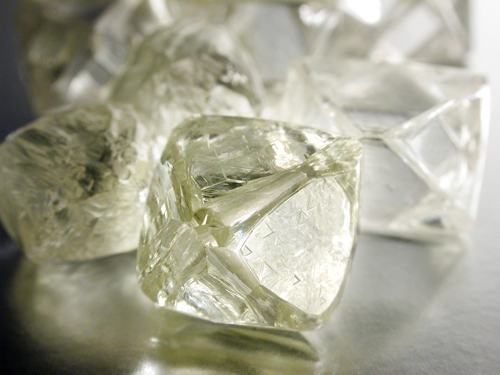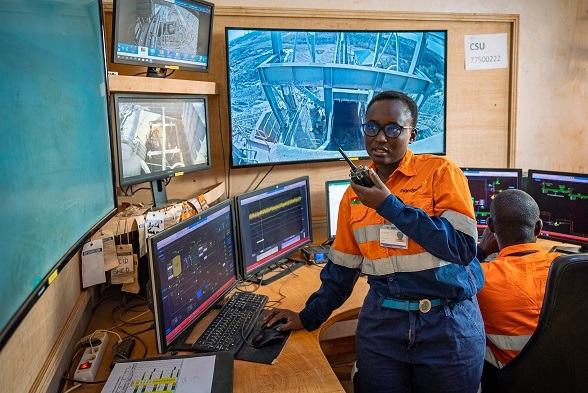
Everyone agrees that diamonds are special. De Beers is unlike other mineral extraction businesses in that, while it is involved in the familiar geological and feasibility work followed by mining and beneficiation, it follows that up with the production and marketing of a luxury end product. It deals in both rough diamonds and finished gemstones, but while diamond may be chemically simple, De Beers recognises 12,000 different categories of rough diamond alone – and that is before they are polished, cut, and set. This makes diamonds less attractive as an investment. Gold is gold, but in the 1980s when a combination of economic factors led people to invest in diamonds, many got their fingers burnt, says Andrew Bone, International Relations Director. “No one would argue that diamonds hold their value and are a good long term store of wealth – but you do have to know just what you are buying.”
Investing in diamonds requires specialist knowledge. The business therefore depends on a lively downstream market to support its trading. Bone says there is every reason to be confident that the market will continue to grow, driven by demand from emerging markets, China in particular. Though 'middle class' is an elusive term to define, Wang Xiaolu, an economist and deputy director of the National Economic Research Institute based in Beijing predicts that the Chinese middle class will rise from just over ten percent of the population in 2009 to over 40 percent in 2020 and more that 70 percent by 2030. They may not all want to buy diamonds, but China is really starting to participate in luxury goods markets, and with midstream and downstream diamond beneficiation, Bone notes. “They are building their capacity to cut and polish rough diamonds, and they already have robust institutions overseeing the industry.” As a good indication of how China is determined to be seen as a responsible trader, it is currently vice-chair of the Kimberley Process, established in 2003 to cut off the trade in conflict diamonds, and will take the chair of that organisation next year.
However the Kimberley Process is only one of a number of ways in which the authenticity and origin of diamonds can be assured. Another is the Forevermark, De Beer's proprietary diamond brand that offers a promise of beauty, rarity and responsible sourcing. Each Forevermark diamond is inscribed with a unique serial number and Forevermark icon, invisible to the naked eye, using proprietary technology . “As a world class company, consumer confidence is paramount to us. To hold onto that you have to always be one step ahead of the issues, plan for them and act accordingly. De Beers is very proactive; always looking to improve existing processes and engaging in new ones.”
In fact, consumer confidence is the driving force in an approach to operating responsibly and sustainably that goes right back to the preliminary geological survey, according to Dr Nicky Black, Head of Social Performance. Right through the value chain, she says, runs the consciousness that company as a discretionary, luxury product, diamonds are uniquely exposed to reputational damage, as without consumer confidence that the diamonds they are buying have been mined, cut, and polished in an environmentally and socially responsible way demand will evaporate. “That's why we established our Best Practice Principles (BPPs) Assurance Programme. Through this bespoke compliance programme, the social, environmental and ethical performance of our own operations and those of our customers is independently verified. Uniquely within compliance programmes, De Beers asks our customers to meet these requirements as a condition of our supplying them.” Sightholders – customers who purchase rough diamonds from De Beers' mines – have been required to comply with BPPs since 2005. Contractors who derive 75 percent or more of their revenue from any De Beers Sightholder or business have participated in the assurance programme since 2008. Other contractors have to sign a declaration of integrity stating that they are free of any material breaches of the BPP standards.
So far reaching is the programme that today more than 330,000 people in the diamond industry world-wide are covered by it – between them, she adds, De Beers Sightholders cut and polish more than 60 percent of all diamonds sold worldwide. However, while making sure the downstream trade behaves properly is of existential importance to the business, De Beers does not lose sight of its need to operate sustainably and ethically at the government level. Diamonds are the bedrock of economies such as those of Namibia and Botswana, where De Beers has 50/50 Joint Venture partnerships with the Governments, and still a big contributor to that of South Africa where De Beers started. And wherever diamonds are mined they have a direct impact on the surrounding community.
Speaking as De Beers' responsible business lead, Dr Black is understandably partisan, but her argument is compelling. “I believe our partnership approach has been particularly powerful in supporting development. Certainly our Joint Venture partnerships with the governments of Botswana and Namibia speak for themselves. Over the past 50 year Botswana has been the great success story of southern Africa and has turned its diamonds into lasting national wealth, with four out of every five dollars generated by our diamond related activities staying in the country.” The Government of Botswana also holds a 15 percent stake in De Beers, in addition to its 50/50 Joint Venture partnership with De Beers in the diamond mining company Debswana. This partnership has helped transform an essentially agricultural economy into a nation with one of the highest economic growth rates in the world.
It is certainly true that the policy of establishing a downstream industry in southern Africa has been a great success. Ten percent of all rough diamonds from Namibia, for example, being retained and sold locally to the 13 Sightholders that have now set up indigenous companies that currently employ at least 1,250 Namibians.
Now De Beers is really stepping up to its principles by transferring a huge chunk of its key HQ diamond sorting, valuation and sales operations from London to Gaborone. “This is a bold move, I know,” says Bone, “it is in the forefront of the move to foster 'resource nationalism', and not without risk. But we think it is the right thing to do. It will transfer a lot of value to Botswana on top of what we have already done there in the past.” As well as the hundreds of direct jobs being transferred, the move will act as a catalyst to other business activity in the banking, hospitality and industrial sectors, he points out.
The move is taking place right now and will be complete by the end of the year, making Gaborone a centre as important to the diamond industry as London, Johannesburg or Antwerp. The impact of De Beers' activities on the other economies of southern Africa cannot be overemphasised. The $2 billion it has announced it will spend on opening underground workings at its Venetia mine in South Africa, that country's largest, would prolong its life by at least 20 years, during which De Beers will devote itself to creating sustainable alternative employment after the mine closes. One of the most effective ways it is doing this is through its involvement in the Zimele initiative. Started in 2008, Zimele's programme focuses on those mining communities and impoverished areas that supply the De Beers workforce. By encouraging the start-up of sustainable indigenous enterprises it aims to create 25,000 employment opportunities and 1,500 companies by 2015. “We have seven hubs, located near our operations in South Africa,” says Dr Black, “and we are currently looking at supporting similar initiatives in Namibia and Botswana as well.”
And stimulating economic development is far from the whole story. Sustainable initiatives generally include elements of education, environmental best practice, healthcare and conservation as well. Mining activities account for only a fifth of the area that is under lease to De Beers and a number of conservation and biodiversity projects have been started under The Diamond Route, a joint venture between De Beers, the Oppenheimer family and the black economic empowerment (BEE) company Ponahalo Holdings. Often these highly protected lease areas prove a haven for wildlife. “A good example is the Orapa mine in Botswana,” explains Andrew Bone. “A rhino conservation project was introduced at Orapa last year: now 15 rhinos are happily breeding there and it is remarkable programme.
Written by John O’Hanlon, research by Robert Hodgson
DOWNLOAD
 DeBeers-AM-Mining-July13-Bro-s.pdf
DeBeers-AM-Mining-July13-Bro-s.pdf












